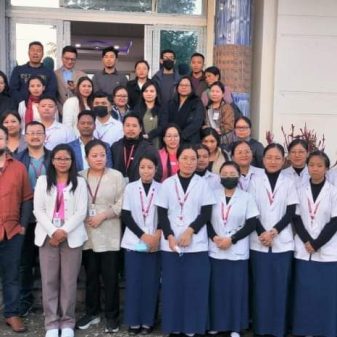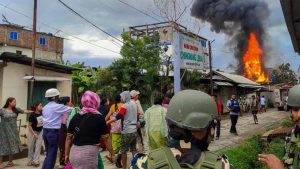
Imphal (Agency): September 3rd marks four months since ethnic conflict first broke out in Manipur. Businesses are at a standstill, offices have been shut for months now, tourism prospects in the state have all but withered and the state is staring at a possible famine. Often ignored is the question: how is the common man earning his bread? IndiaTimes finds out the ground reality in Manipur.
Unprecedented loss, Manipur headed towards stagflation: Professor Chinglen Maisnam, Department of Economics, Manipur University emphasises that there has been an unprecedented loss in all sectors of the economy.
The actual extent of the damage done to its economy can only be judged once proper research is done, but Prof. Maisnam said, speaking to IndiaTimes, “Current violence in Manipur has brutally squeezed the state’s economy.”
What has been more damaging is the fact that this has come close on the heels of the COVID-19 catastrophe, from which the state has not yet recovered completely.
Due to the pandemic and lockdown , Manipur’s GSDP had declined from Rs. 37,681.93 crore in 2020-21 to Rs. 32,852.46 crore in 2021-22 (Projected). The growth rate had drastically declined from 25.06 % to 3.34% in the same period.
As a result of the ongoing violence, Maisnam expects a further sharp fall in growth rate because of slowing investment growth and slackening consumption demand. In fact, he says that the state is headed for a serious economic stagflation.
Stagflation is an economic cycle characterised by slow growth and a high unemployment rate, leading to stagnation, and accompanied by inflation. Economic policymakers usually find this combination difficult to handle since attempting to correct one of the factors can exacerbate another.
Maisnam pointed out that Manipur’s retail price inflation for the month of July 2023 was at an alarming 9.5 per cent.
“A continued rise in prices would push people into even greater hardship and cost-of-living crisis risks,” Maisnam adds. The mounting inflation (especially food inflation), he believes, will force people to squeeze their purse strings, push family budgets to the edge and enlarge indebtedness. This inflation, combined with the current deterioration in labour market situation across urban and rural segments, would ultimately push the state into stagflation.
“The present crisis caused thousands of people to lose their jobs mainly due to the breakdown of the economic and commercial activities,” Maisnam says.
Maisnam calls for a powerful fiscal and monetary intervention along with judicious relief package both from the centre and state.The urgent need of the hour, he states, is a “proper assessment of the losses that the people of the state have suffered, and adequate compensation must be given. The government must provide livelihood opportunities for the jobless.”
Hotels and food chains losing out the most as tourism gets hit: Thangjam Dhabali Singh, founder of BABINA Healthcare and Hospitality Industries Pvt Ltd in Manipur and owner of luxury hotels in the state, points out that the occupancy of hotels in Manipur before and after the conflict has drastically declined.
“While before 3rd May 2023, the average occupancy of the hotels in the city was around 67%, it dropped to below 5% after 3rd May. Further, most hotels are now closed temporarily due to operational reasons,” Dhabali says.
He adds, “In food service too, most of the restaurants have remained shut for almost three months. Only a few restaurants which are attached to hotels are operational. The revenue of the food business is impacted and has dropped by 80% – 90% during the last three months.”
Majority of the travellers currently visiting the state are government officials, media persons, politicians and occasional business travellers. Dhabali points out that it will take time for the leisure travellers to start visiting again.
“Once the violence subsides and the law and order situation is back to normalcy, the state and centre must put in all efforts to gain back the confidence of the travelers. National level events, functions and meetings could be organized in Manipur as evidence. Word of mouth publicity and also the national media will play important role to show that Manipur is back to normal and safe to travel. Once the resettlement of all victims affected by this violence are completed, tourism promotional activities could also be resumed,” says Dhabali.
Waikhom Ibohal, Director of Tourism, Manipur underlines that in order to promote Manipur as a safe space for travel once the crisis is over, there is a need to improve security measures and strengthen law and order, provide accurate and up-to-date information about the safety situation in Manipur, invest in improvement of infrastructure, including roads, airports, and public transport, to ensure ease of movement for tourists and engage with the media to promote Manipur as a safe and attractive destination for travel.
Ibohal also believes that it is necessary to organise events or festivals that celebrate the rich culture and heritage of Manipur, and encourage local participation, while doing so.
“Any kind of violence or instability in a region is likely to have an impact on tourism. Tourists tend to avoid areas that are perceived as unsafe or unstable… it is important for locals to take measures to ensure the safety and security of tourists and promote a positive image of the region.”
Threat to food security: More than 10,000 hectares of agricultural land in the foothill areas might not see paddy plantation this season thereby leading to an imminent shortage of food-grains in the state by 30-40,000 metric tonnes, according to survey undertaken by the Irabot Foundation, an Imphal-based non-profit, in July.
Irabot Foundation president Gopen Luwang had said that around 1 lakh people may be deprived of a sufficient share of rice.
He said that one of the major factors contributing to the state’s agricultural crisis is the unprovoked attacks on farmers by suspected militants in peripheral areas near the foothills. Frequent attacks have instilled fear among farmers, discouraging them from cultivating their lands.
While we have all heard stories of horror from Manipur – from rape to cold-blooded killing to arson – what has been ignored is the fate of the common man. Would Manipur ever return to normalcy? Or is this now their new ‘normal’? (Courtesy: India Times)





